

Organizational Awareness: Reading Collective Emotions. How to Rewire Your Brain to Be More Kind Toward Others. Kindness is the state of caring about other people’s well-being and taking action to help make other people’s lives better and happier.

It is a social glue that allows us to connect with others and build meaningful relationships with them When someone does something kind for us, we like them more and we want to cooperate with them more. When we do something kind for someone, we earn their trust and respect, and we feel better about ourselves for being a good person. Kindness is a reciprocal relationship. It becomes a cycle that strengthens our bond with friends, family, lovers, coworkers, and acquaintances. The more we practice kindness, the easier it is. Every thought and action we do fires neurons in our brain. Here are scientifically supported ways we can increase our kindness toward others. Get your intentions right Having good intentions is the first step toward being kinder toward others and building positive relationships with them. Attribution Errors. Letting Go of Judging People. By Leo Babauta One of the best changes I’ve made to help me be happier is learning to see judging other people as a red flag.
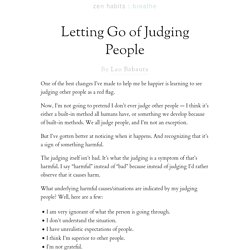
Now, I’m not going to pretend I don’t ever judge other people — I think it’s either a built-in method all humans have, or something we develop because of built-in methods. We all judge people, and I’m not an exception. But I’ve gotten better at noticing when it happens. And recognizing that it’s a sign of something harmful. The judging itself isn’t bad.
What underlying harmful causes/situations are indicated by my judging people? I am very ignorant of what the person is going through.I don’t understand the situation.I have unrealistic expectations of people.I think I’m superior to other people.I’m not grateful.I’m being self-centered.I’m not being curious, but instead I close off all learning.I can’t really help the situation from a place of judgment. How That Happens What’s going on in this example? You can see how all of these things are harmful. Practicing Non-Judgment. By Leo Babauta We go through our day judging our experiences, other people, ourselves: this is good, this is bad.
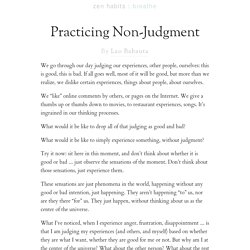
If all goes well, most of it will be good, but more than we realize, we dislike certain experiences, things about people, about ourselves. We “like” online comments by others, or pages on the Internet. We give a thumbs up or thumbs down to movies, to restaurant experiences, songs. It’s ingrained in our thinking processes. What would it be like to drop all of that judging as good and bad? What would it be like to simply experience something, without judgment? Try it now: sit here in this moment, and don’t think about whether it is good or bad … just observe the sensations of the moment. These sensations are just phenomena in the world, happening without any good or bad intention, just happening.
Fundamental attribution error. In social psychology, fundamental attribution error (FAE), also known as correspondence bias or attribution effect, is the tendency for people to under-emphasize situational explanations for an individual's observed behavior while over-emphasizing dispositional and personality-based explanations for their behavior.
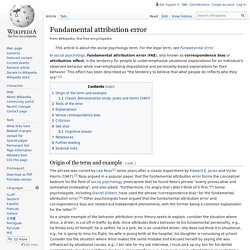
This effect has been described as "the tendency to believe that what people do reflects who they are".[1] Origin of the term and example[edit] As a simple example of the behavior attribution error theory seeks to explain, consider the situation where Alice, a driver, is cut off in traffic by Bob. Alice attributes Bob's behavior to his fundamental personality, e.g., he thinks only of himself, he is selfish, he is a jerk, he is an unskilled driver; she does not think it is situational, e.g., he is going to miss his flight, his wife is giving birth at the hospital, his daughter is convulsing at school.
Classic demonstration study: Jones and Harris (1967)[edit] Explanations[edit] How to Practice Naikan Reflection. The Three Questions Naikan reflection is based on three questions: What have I received from __________ ?
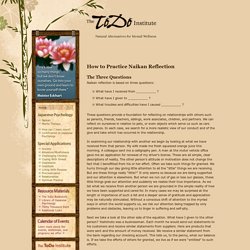
What have I given to __________ ? What troubles and difficulties have I caused __________ ? These questions provide a foundation for reflecting on relationships with others such as parents, friends, teachers, siblings, work associates, children, and partners. In examining our relationship with another we begin by looking at what we have received from that person. Next we take a look at the other side of the equation. “A hundred times a day I remind myself that my inner and outer life depends on the labors of other men, living and dead, and that I must exert myself in order to give in the measure as I have received and am still receiving.”Albert Einstein.
Naikan. Naikan. Naikan (Japanese: 内観, lit.
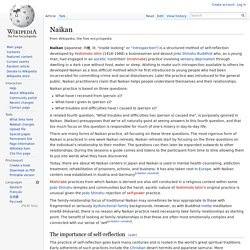
“inside looking” or “introspection”) is a structured method of self-reflection developed by Yoshimoto Ishin (1916-1988) a businessman and devout Jodo Shinshu Buddhist who, as a young man, had engaged in an ascetic 'contrition' (mishirabe) practice involving sensory deprivation through dwelling in a dark cave without food, water or sleep. Wishing to make such introspection available to others he developed Naikan as a less difficult method which he first introduced to young people who had been incarcerated for committing crime and social disturbances. Later the practice was introduced to the general public. Naikan practitioners claim that Naikan helps people understand themselves and their relationships.